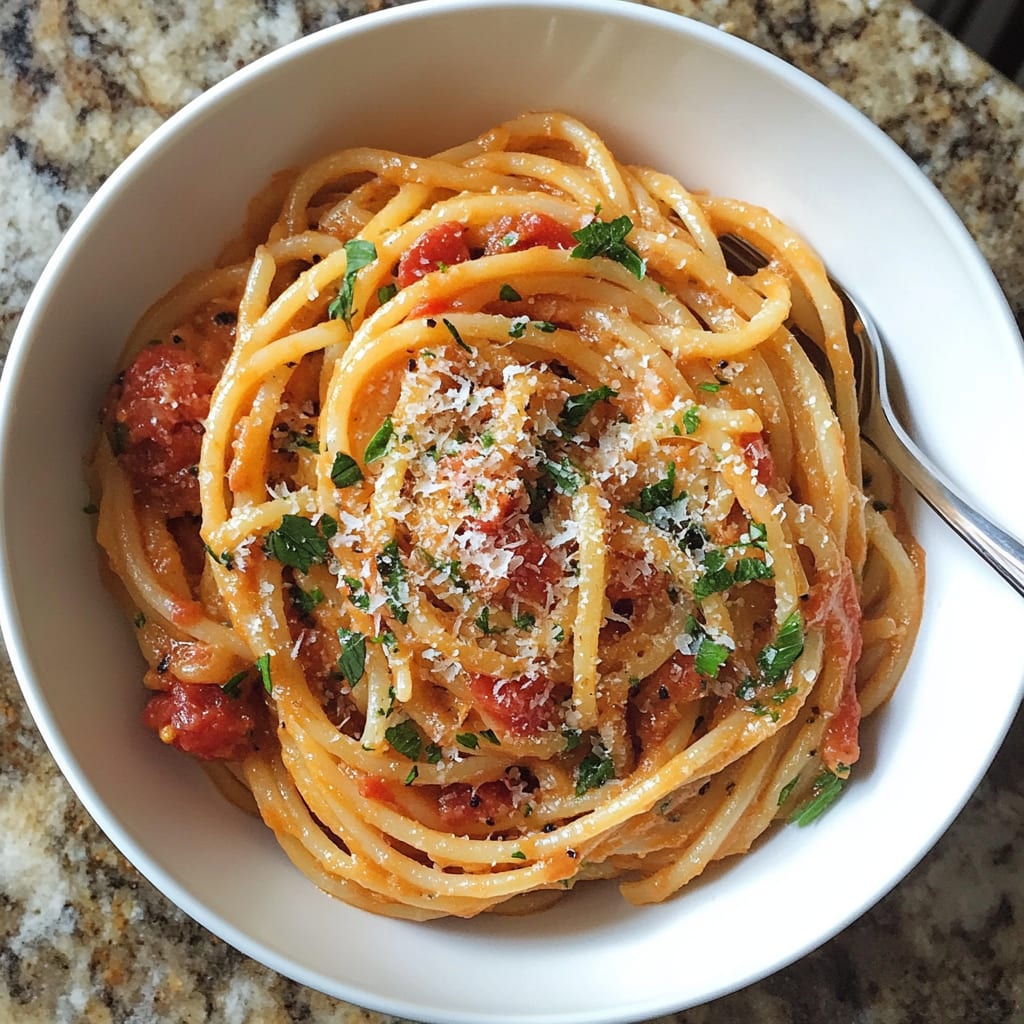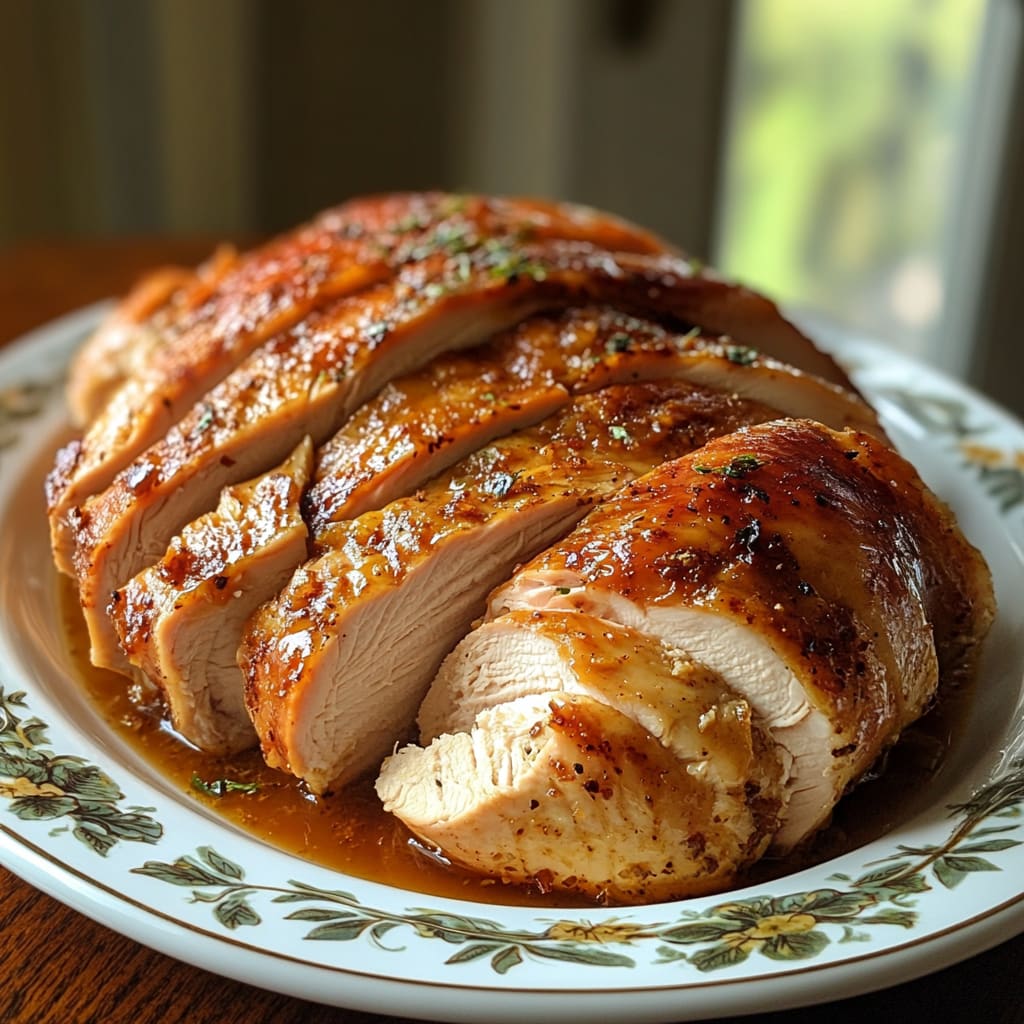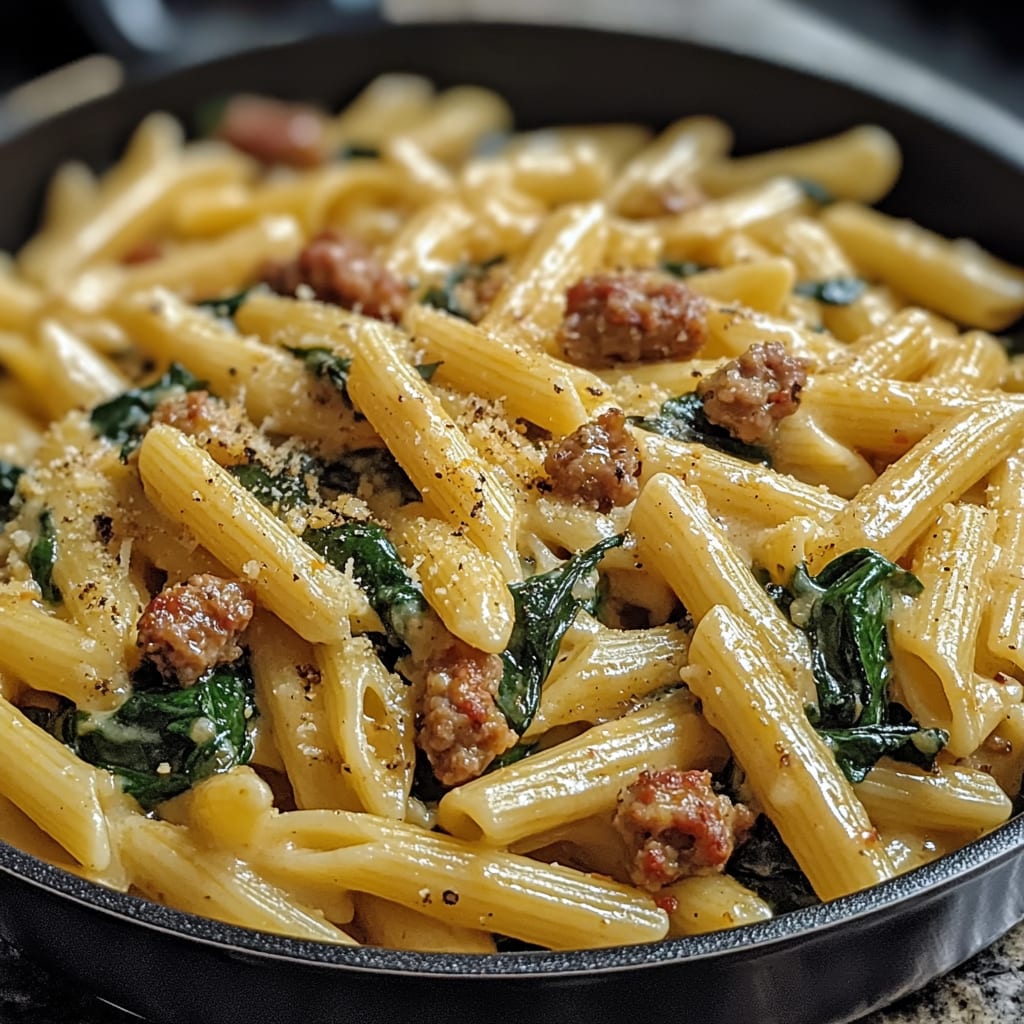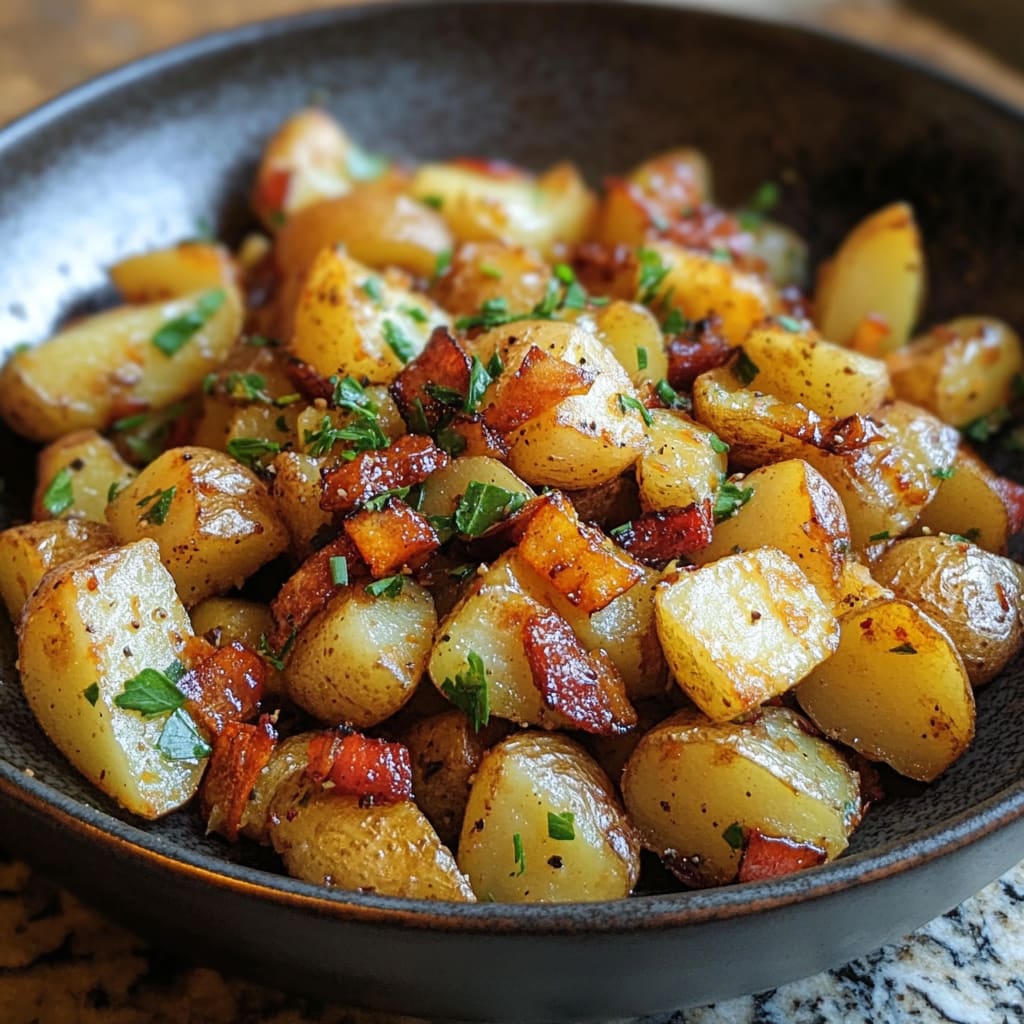The rich, aromatic scent of tomatoes simmering with garlic and herbs announces the arrival of authentic Pasta Napoletana to your kitchen. This classic Italian dish captures the essence of Naples with its vibrant red sauce coating perfectly al dente pasta. The beauty of Pasta Napoletana lies in its elegant simplicity – a celebration of quality ingredients coming together in perfect harmony. You’ll learn how to create this timeless dish that has graced Italian tables for generations, with techniques to ensure your sauce develops that distinctive depth of flavor that makes Pasta Napoletana so irresistible.
Why You’ll Love This Recipe
Pasta Napoletana exemplifies the Italian culinary philosophy that exceptional food doesn’t require complexity – just quality ingredients and proper technique. This tomato-based pasta sauce balances brightness with depth, creating a velvety coating that clings perfectly to your pasta of choice. The contrast between the slight acidity of tomatoes and the richness of olive oil creates a mouthwatering tension that keeps you coming back for another bite.
What makes this recipe truly special is its versatility. Whether you’re planning a quick weeknight dinner or looking to impress weekend guests, Pasta Napoletana delivers consistent, restaurant-quality results. The sauce develops a remarkable complexity as it simmers, creating layers of flavor that belie its straightforward preparation.
Perhaps most appealing is how this traditional Neapolitan sauce celebrates seasonal produce. In summer, use garden-fresh tomatoes for a bright, vibrant sauce; in winter, quality canned tomatoes provide comfort and warmth. This authentic Italian tomato sauce recipe connects you to centuries of culinary tradition while remaining perfectly suited to modern tastes.
Ingredients
For 4 servings of Pasta Napoletana:
• 1 pound (450g) pasta (spaghetti, linguine, or rigatoni work beautifully)
• 2 pounds (900g) ripe tomatoes or 28 oz (800g) canned San Marzano tomatoes
• 1/4 cup (60ml) extra virgin olive oil
• 4 cloves garlic, thinly sliced
• 1 small onion, finely diced (about 1 cup)
• 1 carrot, finely diced (optional, for sweetness)
• 1 teaspoon dried oregano
• 1/4 teaspoon red pepper flakes (optional)
• 1 small bunch fresh basil (about 20 leaves)
• 2 tablespoons unsalted butter (optional, for richness)
• Salt and freshly ground black pepper, to taste
• Freshly grated Parmesan or Pecorino Romano cheese, for serving
The cornerstone of authentic Neapolitan sauce is quality tomatoes. San Marzano tomatoes, grown in the volcanic soil near Naples, offer the perfect balance of sweetness and acidity. For the olive oil, choose a robust extra virgin variety to provide that distinctive Mediterranean flavor that defines classic Italian tomato sauce.
Pro Tips
Master the Tomato Base: The foundation of exceptional Pasta Napoletana lies in properly preparing your tomatoes. If using fresh tomatoes, blanch them briefly in boiling water, then shock in cold water to easily remove skins. When using canned tomatoes, crush them by hand rather than using pre-crushed varieties – this creates a sauce with more character and varying texture. Allow your tomatoes to release their juices gradually as they simmer, never rushing this crucial development of flavor.
The Importance of Gentle Heat: Unlike many pasta sauces, authentic Pasta Napoletana benefits from patience rather than intensity. Maintain a gentle simmer throughout the cooking process, allowing the sauce to reduce slowly. This methodical approach concentrates flavors while preserving the bright, fresh character of the tomatoes. A vigorous boil will create a bitter, one-dimensional sauce, while the slow simmer develops complexity.
Perfect Pasta Finishing Technique: The marriage between sauce and pasta should occur before serving. Undercook your pasta by about 2 minutes, then finish cooking it directly in the sauce with a splash of pasta water. This starchy water creates an emulsion with the olive oil in the sauce, yielding a silky texture that clings beautifully to each strand or piece. This final minute of cooking allows the pasta to absorb the flavors of the sauce, creating a unified dish rather than simply pasta topped with sauce.
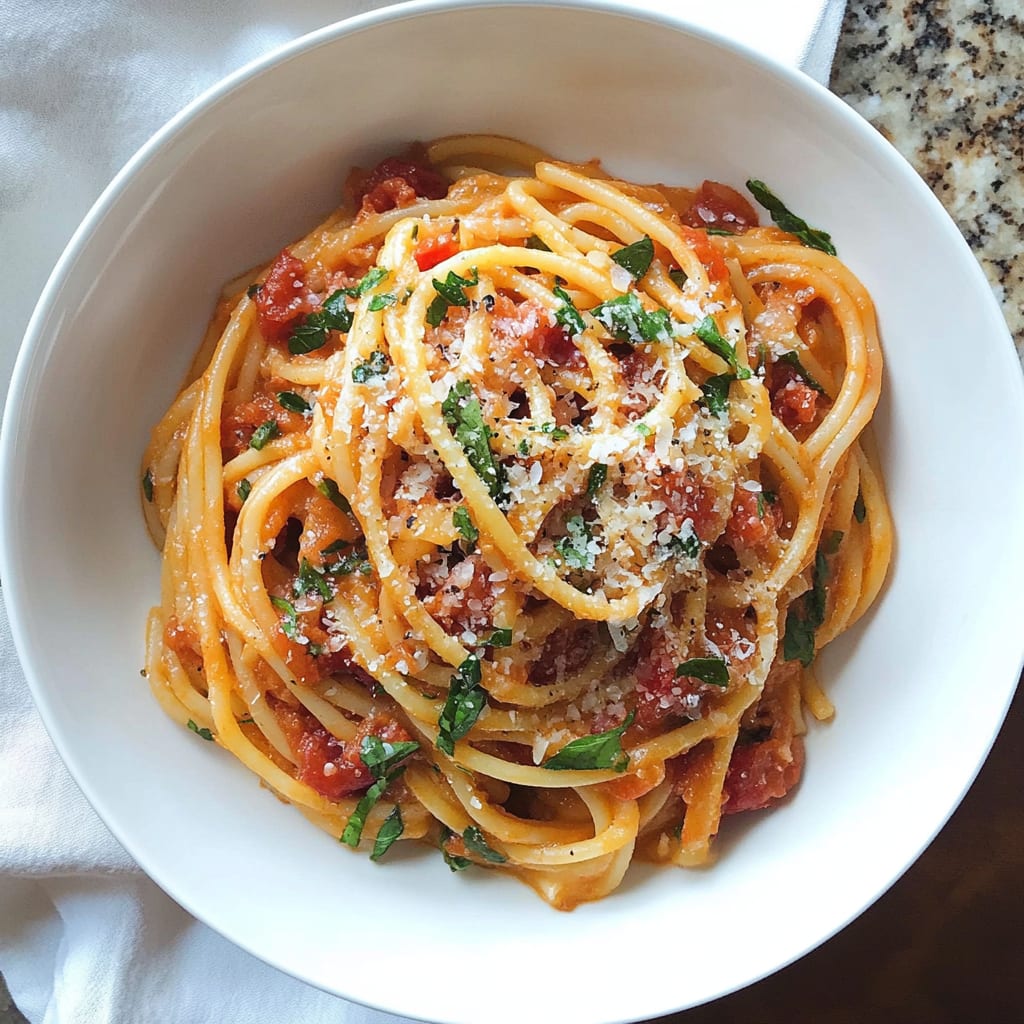
Instructions
Step 1: Prepare Your Tomatoes
If using fresh tomatoes, bring a large pot of water to boil. Score an X on the bottom of each tomato and blanch for 30 seconds. Transfer to an ice bath, then slip off the skins. Cut in half, remove seeds if desired, and roughly chop. If using canned tomatoes, open and have ready for use. This preparation ensures your Pasta Napoletana has that perfectly smooth yet slightly chunky texture characteristic of authentic Neapolitan sauce.
Step 2: Start The Sauce Base
Heat the olive oil in a large, heavy-bottomed pan over medium-low heat. Add the finely diced onion and cook gently for 4-5 minutes until translucent but not browned. Add the diced carrot if using, and continue cooking for another 3 minutes. This slow sweating of the aromatics creates a sweet foundation for your Pasta Napoletana.
Step 3: Add The Garlic And Seasonings
Add the sliced garlic to the pan and cook for just 30-60 seconds until fragrant. Be careful not to let it brown, as this can make your sauce bitter. Stir in the dried oregano and red pepper flakes (if using), allowing the heat to release their essential oils. These aromatic elements provide the characteristic warming notes in traditional Pasta Napoletana.
Step 4: Incorporate The Tomatoes
Add your prepared tomatoes to the pan, along with a generous pinch of salt and some freshly ground black pepper. Tear half of your fresh basil leaves and add them to the sauce. Bring to a gentle simmer, then reduce the heat to maintain a barely bubbling surface. Let the sauce cook uncovered for 25-30 minutes, stirring occasionally. The sauce will gradually thicken and develop that rich flavor profile that makes Pasta Napoletana so beloved.
Step 5: Cook The Pasta And Finish The Dish
While the sauce simmers, bring a large pot of generously salted water to a boil. Cook your pasta until 2 minutes shy of the package directions for al dente. Reserve 1 cup of the starchy pasta water before draining. Transfer the pasta directly to the sauce, adding about 1/4 cup of the reserved pasta water. Continue cooking, tossing constantly, for about 2 minutes until the pasta is perfectly al dente and well-coated with sauce. If desired, add the optional butter and stir until melted for added richness. Remove from heat and fold in the remaining fresh basil leaves.
Serve your Pasta Napoletana immediately in warmed bowls, topped with freshly grated cheese. The authentic flavors of Naples will transport you straight to the Italian coastline with every bite.
Variations
Pasta Napoletana with Seafood: Transform this classic into a coastal Italian delight by adding seafood in the final minutes of cooking. Sauté 1/2 pound of cleaned shrimp or calamari rings with a touch of garlic in a separate pan until just opaque, then fold into the finished sauce. The sweet, briny notes of seafood pair beautifully with the tomato base, creating a seafood pasta Napoletana that captures the essence of Mediterranean cuisine.
Vegetable-Enriched Napoletana: For a nutrition boost that maintains authenticity, add diced eggplant, bell peppers, and zucchini to the sauce after the onions have softened. Allow these vegetables to cook down and meld with the tomatoes, creating a heartier version that resembles the classic southern Italian vegetable stew, caponata. This garden vegetable pasta Napoletana offers more texture and nutritional value while honoring the traditional flavor profile.
Spicy Napoletana: For heat lovers, transform your Pasta Napoletana into an arrabbiata-style sauce by doubling the red pepper flakes and adding them earlier in the cooking process to infuse the oil. This spicy tomato pasta Napoletana delivers a warming kick that pairs perfectly with a cool glass of wine and brings a different dimension to the classic recipe without compromising its essential character.
Storage and Serving
The sauce for Pasta Napoletana actually improves with time, making it perfect for preparing ahead. Store leftover sauce (without pasta) in an airtight container in the refrigerator for up to 5 days. For longer storage, freeze in portion-sized containers for up to 3 months. Thaw overnight in the refrigerator before reheating gently on the stovetop. If your Pasta Napoletana already has pasta mixed in, refrigerate for up to 2 days and revive with a splash of water when reheating.
For a complete Italian dining experience, serve your Pasta Napoletana as the primo piatto (first course) followed by a simple protein main. Alternatively, transform it into a satisfying one-dish meal by accompanying it with a peppery arugula salad dressed simply with lemon juice and olive oil. The bright acidity of the greens provides perfect contrast to the rich tomato sauce.
For a show-stopping presentation, serve your Pasta Napoletana in a large, warmed platter with extra fresh basil leaves scattered over the top and a small bowl of additional grated cheese on the side. This family-style service encourages the conviviality that Italian food celebrates.
FAQs
Can I make Pasta Napoletana with fresh tomatoes year-round?
While summer tomatoes deliver superior flavor, high-quality canned San Marzano tomatoes are actually preferred by many Italian chefs year-round for their consistent sweetness and acidity. They’re harvested at peak ripeness, making them an excellent choice when fresh tomatoes are out of season.
Is it necessary to remove tomato skins for Pasta Napoletana?
Yes, removing skins creates the silky texture authentic to Pasta Napoletana. Tomato skins can become tough and separate from the sauce during cooking, creating an unpleasant texture. The brief blanching method makes skin removal quick and effortless.
How can I thicken my Pasta Napoletana sauce if it’s too watery?
Continue simmering uncovered, allowing natural reduction. Authentic Pasta Napoletana should never include tomato paste or cornstarch as thickeners. If needed, remove some liquid with a ladle, but remember that the sauce will thicken further when finished with the pasta.
What’s the best pasta shape to use with Napoletana sauce?
Traditional Neapolitan cooks typically use long pasta like spaghetti or linguine, but tubular shapes like rigatoni or penne also work wonderfully with Pasta Napoletana, as their ridges and hollow centers capture the sauce effectively.
Can I add meat to authentic Pasta Napoletana?
Traditional Pasta Napoletana is vegetarian, celebrating the pure flavor of tomatoes. For a meat version, you’d technically be making a different sauce such as ragù. However, you can certainly add meatballs alongside your Pasta Napoletana for a satisfying variation that respects both traditions.
Conclusion
This Pasta Napoletana is comfort food at its finest — a timeless celebration of tomatoes transformed into a silky, flavorful sauce that embraces every strand of pasta with Mediterranean warmth. It’s the kind of dish that connects you to generations of Italian home cooks who understood that true culinary magic often comes from simplicity and respect for ingredients. Whether serving it for a casual family dinner or a special gathering of friends, this Pasta Napoletana brings a taste of Naples to your table with authentic flavor that reminds us why Italian cuisine has captivated the world for centuries.
Print
Pasta Napoletana
- Prep Time: 20 minutes
- Cook Time: 30 minutes
- Total Time: 50 minutes
- Yield: 4 servings 1x
- Category: Dinner
- Method: Simmering
- Cuisine: Americaine
Description
Pasta Napoletana: Classic Italian comfort food. Rich tomato sauce, garlic, olives, capers, and anchovies create a savory, satisfying dish.
Ingredients
- 1 pound (450g) pasta (spaghetti, linguine, or rigatoni work beautifully)
- 2 pounds (900g) ripe tomatoes or 28 oz (800g) canned San Marzano tomatoes
- 1/4 cup (60ml) extra virgin olive oil
- 4 cloves garlic, thinly sliced
- 1 small onion, finely diced (about 1 cup)
- 1 carrot, finely diced (optional, for sweetness)
- 1 teaspoon dried oregano
- 1/4 teaspoon red pepper flakes (optional)
- 1 small bunch fresh basil (about 20 leaves)
- 2 tablespoons unsalted butter (optional, for richness)
- Salt and freshly ground black pepper, to taste
- Freshly grated Parmesan or Pecorino Romano cheese, for serving
Instructions
- Step 1: Prepare Your Tomatoes If using fresh tomatoes, bring a large pot of water to boil. Score an X on the bottom of each tomato and blanch for 30 seconds. Transfer to an ice bath, then slip off the skins. Cut in half, remove seeds if desired, and roughly chop. If using canned tomatoes, open and have ready for use. This preparation ensures your Pasta Napoletana has that perfectly smooth yet slightly chunky texture characteristic of authentic Neapolitan sauce.
- Step 2: Start The Sauce Base Heat the olive oil in a large, heavy-bottomed pan over medium-low heat. Add the finely diced onion and cook gently for 4-5 minutes until translucent but not browned. Add the diced carrot if using, and continue cooking for another 3 minutes. This slow sweating of the aromatics creates a sweet foundation for your Pasta Napoletana.
- Step 3: Add The Garlic And Seasonings Add the sliced garlic to the pan and cook for just 30-60 seconds until fragrant. Be careful not to let it brown, as this can make your sauce bitter. Stir in the dried oregano and red pepper flakes (if using), allowing the heat to release their essential oils. These aromatic elements provide the characteristic warming notes in traditional Pasta Napoletana.
- Step 4: Incorporate The Tomatoes Add your prepared tomatoes to the pan, along with a generous pinch of salt and some freshly ground black pepper. Tear half of your fresh basil leaves and add them to the sauce. Bring to a gentle simmer, then reduce the heat to maintain a barely bubbling surface. Let the sauce cook uncovered for 25-30 minutes, stirring occasionally. The sauce will gradually thicken and develop that rich flavor profile that makes Pasta Napoletana so beloved.
- Step 5: Cook The Pasta And Finish The Dish While the sauce simmers, bring a large pot of generously salted water to a boil. Cook your pasta until 2 minutes shy of the package directions for al dente. Reserve 1 cup of the starchy pasta water before draining. Transfer the pasta directly to the sauce, adding about 1/4 cup of the reserved pasta water. Continue cooking, tossing constantly, for about 2 minutes until the pasta is perfectly al dente and well-coated with sauce. If desired, add the optional butter and stir until melted for added richness. Remove from heat and fold in the remaining fresh basil leaves.
Notes
Fresh ingredients will always yield the best flavor results.
Nutrition
- Serving Size: 1 plate
- Calories: 400 calories per serving
- Sugar: 8 grams
- Sodium: 600 mg
- Fat: 15 grams
- Saturated Fat: 3 grams
- Unsaturated Fat: 12 grams
- Trans Fat: 0 grams
- Carbohydrates: 60 grams
- Fiber: 5 grams
- Protein: 10 grams
- Cholesterol: 10 mg

